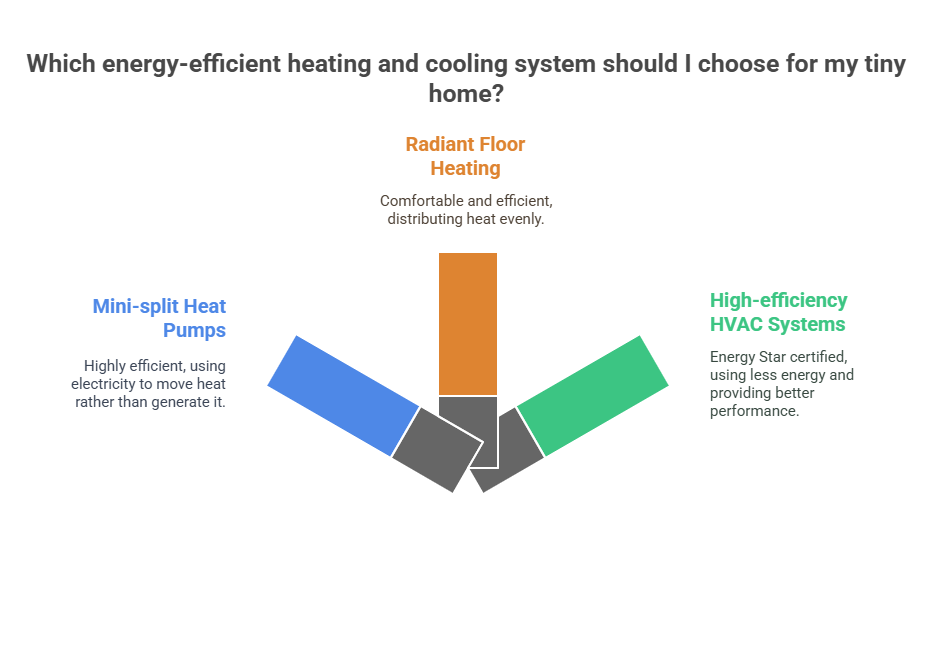Energy-Efficient Options For Your Tiny Home

One of the key benefits of tiny homes is their energy efficiency, as they are typically much smaller than traditional homes and require less energy to heat, cool, and power. Energy efficiency is also important for reducing our carbon footprint, which is essential for mitigating the impacts of climate change. In this article, we will explore a variety of energy-efficient options for tiny homes that can help save energy, reduce costs, and lessen our impact on the environment. Let’s dive in.
Energy-Efficient Heating and Cooling
Heating and cooling are essential components of any home, and this is especially true for tiny homes, which are often built with less insulation than traditional homes. As a result, it's important to choose energy-efficient heaters and coolers that can provide comfort while also reducing energy usage and costs.
Options for energy-efficient heating and cooling systems
There are several options for energy-efficient heating and cooling in tiny homes, including mini-split heat pumps, radiant floor heating, and high-efficiency HVAC systems.
Mini-split heat pumps are a popular option, as they use electricity to move heat from the outside air to the inside of the home, rather than generating heat from scratch. This can be up to 60% more efficient than traditional heating methods.
Radiant floor heating is another option, which uses tubes or electric coils installed under the floor to heat the space. This is a comfortable and efficient option, as the heat is distributed evenly throughout the room.
High-efficiency HVAC systems, such as those with Energy Star certification, are also a good option, as they use less energy and provide better performance than traditional systems.
The cost and environmental benefits of each system will vary, but in general, they can help to significantly reduce energy usage and costs, while also reducing the home's carbon footprint. To maximize energy efficiency, it's important to properly size and install the system, as well as use programmable thermostats, and maintain regular maintenance.

Energy-Efficient Lighting
Lighting is an important part of any home, but it can have a significant impact on energy usage in tiny homes, which have limited space and therefore fewer lights. Choosing energy-efficient lighting options can help to reduce energy usage and costs, while also providing adequate lighting for the space.
Options for energy-efficient lighting
LED lights are a popular choice for tiny homes because they are incredibly energy-efficient and can last up to 50 times longer than traditional incandescent bulbs. They also produce very little heat, which can be beneficial in small spaces where overheating can be a problem. LED lights are available in a variety of colors and styles, making them a versatile option for any tiny home.
Motion sensors are another energy-efficient lighting option for tiny homes. These sensors can detect when someone enters a room and turn the lights on automatically. When the room is empty, the lights turn off, reducing energy waste. This option is particularly useful in spaces like bathrooms or hallways, where people may only need light for a short period of time.
Skylights are a great option for tiny homes that want to maximize natural lighting while reducing energy costs. Skylights allow natural light to enter the space, reducing the need for artificial lighting during the day. They also provide ventilation, which can help regulate the temperature in the home.

Energy-Efficient Appliances
With limited space and resources, homeowners need to ensure that their appliances are not only functional but also efficient. Energy-efficient appliances can save homeowners money on their energy bills, while also reducing their carbon footprint. In addition, they are more durable and tend to require less maintenance.
One way to incorporate energy efficiency into a tiny home is by using appliances that are specifically designed for small spaces. Here are a few examples of energy-efficient appliances that are ideal for tiny homes:
Induction cooktop: Induction cooktops are energy-efficient because they heat up quickly and use less energy than traditional gas or electric stoves. They are also safer to use, as they only heat up when a pan is placed on them.
Tankless water heater: Tankless water heaters are an excellent option for tiny homes because they only heat water when it's needed, rather than constantly keeping a tank of water hot. This means they use less energy and take up less space.
Heat pump dryer: Heat pump dryers are an energy-efficient alternative to traditional dryers. They use less energy by recycling the hot air they create, rather than venting it outside. They are also gentler on clothes, making them a great choice for those who want to extend the life of their clothing.
Dishwasher: Many people believe that washing dishes by hand is more energy-efficient than using a dishwasher, but this is not always the case. Energy-efficient dishwashers can actually use less water and energy than hand-washing. Make sure you choose models that use less water per cycle.
Final Thoughts
It's important to emphasize that there are a variety of options available for making your tiny home more energy-efficient. From choosing the right heating and cooling system to selecting energy-efficient appliances and lighting, there are many ways to reduce energy usage and costs. Additionally, renewable energy options, such as solar panels can provide a reliable source of energy that is both sustainable and eco-friendly.
We encourage readers to prioritize sustainability when it comes to their tiny homes. Making energy-efficient choices can significantly decrease our carbon footprint and contribute to mitigating the effects of climate change. Whether constructing a tiny home from the ground up or updating an existing one, we hope these suggestions serve as a source of inspiration.









